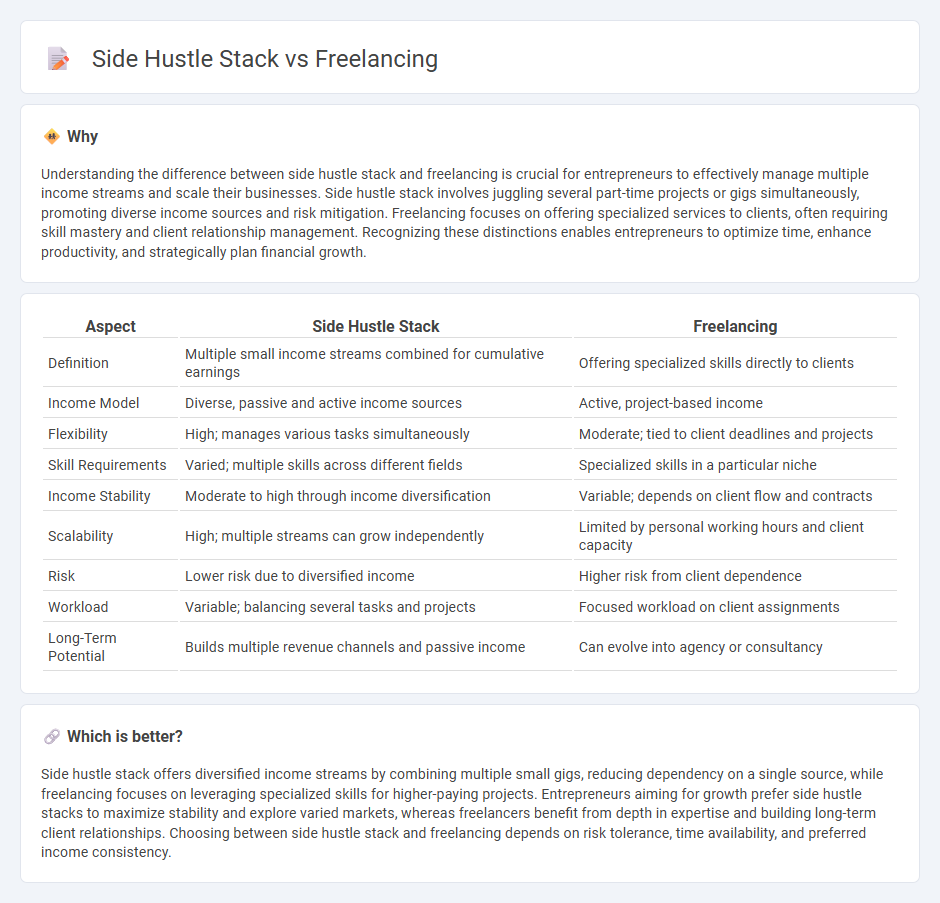
Entrepreneurship often involves choosing between a side hustle stack--a diversified set of part-time ventures--and freelancing, which focuses on offering specialized services to clients. Side hustle stacks provide multiple income streams and flexibility, while freelancing allows for deeper skill development and client relationships. Explore the advantages and strategies of each approach to find the best fit for your entrepreneurial journey.
Why it is important
Understanding the difference between side hustle stack and freelancing is crucial for entrepreneurs to effectively manage multiple income streams and scale their businesses. Side hustle stack involves juggling several part-time projects or gigs simultaneously, promoting diverse income sources and risk mitigation. Freelancing focuses on offering specialized services to clients, often requiring skill mastery and client relationship management. Recognizing these distinctions enables entrepreneurs to optimize time, enhance productivity, and strategically plan financial growth.
Comparison Table
| Aspect | Side Hustle Stack | Freelancing |
|---|---|---|
| Definition | Multiple small income streams combined for cumulative earnings | Offering specialized skills directly to clients |
| Income Model | Diverse, passive and active income sources | Active, project-based income |
| Flexibility | High; manages various tasks simultaneously | Moderate; tied to client deadlines and projects |
| Skill Requirements | Varied; multiple skills across different fields | Specialized skills in a particular niche |
| Income Stability | Moderate to high through income diversification | Variable; depends on client flow and contracts |
| Scalability | High; multiple streams can grow independently | Limited by personal working hours and client capacity |
| Risk | Lower risk due to diversified income | Higher risk from client dependence |
| Workload | Variable; balancing several tasks and projects | Focused workload on client assignments |
| Long-Term Potential | Builds multiple revenue channels and passive income | Can evolve into agency or consultancy |
Which is better?
Side hustle stack offers diversified income streams by combining multiple small gigs, reducing dependency on a single source, while freelancing focuses on leveraging specialized skills for higher-paying projects. Entrepreneurs aiming for growth prefer side hustle stacks to maximize stability and explore varied markets, whereas freelancers benefit from depth in expertise and building long-term client relationships. Choosing between side hustle stack and freelancing depends on risk tolerance, time availability, and preferred income consistency.
Connection
Side Hustle Stack and freelancing both empower individuals to monetize their skills and generate flexible income streams outside traditional employment. Freelancing platforms integrated within Side Hustle Stack offer curated gig opportunities, enhancing accessibility and diversity of projects for freelancers. This synergy enables entrepreneurs to build sustainable side businesses by leveraging digital marketplaces tailored for independent professionals.
Key Terms
Flexibility
Freelancing offers unmatched flexibility by allowing professionals to choose projects, set their own schedules, and work from any location, creating a tailored work-life balance. Side hustles also provide flexibility but often require consistent commitment alongside a primary job, which can limit availability and spontaneity. Explore further to understand which approach best suits your lifestyle and financial goals.
Income diversification
Freelancing offers flexible income streams by leveraging specialized skills on various projects, enabling professionals to build a diverse client base and mitigate financial risks. Side hustles complement this approach by providing alternative revenue channels, often requiring lower initial investment and tapping into different markets or interests. Explore detailed strategies to maximize income diversification through freelancing and side hustles to enhance financial stability.
Platform selection
Choosing the right platform for freelancing versus a side hustle significantly impacts project quality and income potential. Freelancers often prefer specialized marketplaces like Upwork or Toptal for consistent, high-paying gigs, while side hustlers might opt for more flexible platforms such as Fiverr or TaskRabbit to manage smaller, varied tasks. Explore detailed comparisons to optimize your platform strategy and maximize earnings.
Source and External Links
Freelancing 101: What is Freelancing? - Freelancing is a form of self-employment where you have the freedom to work remotely, choose your clients, and control your work schedule based on your skills and experience.
What Is Freelancing? Basics and Popular Jobs in 2025 - Freelancing involves performing specific tasks for clients without full-time commitment, requiring skills selection, portfolio building, rate setting, professional promotion, and clear communication to succeed.
25 best freelance websites to find work in 2025 - Freelancing offers flexibility, independence in choosing projects and rates, and is accessible for beginners who can start part-time while building skills and clients, with many websites supporting freelancers in finding work.
 dowidth.com
dowidth.com